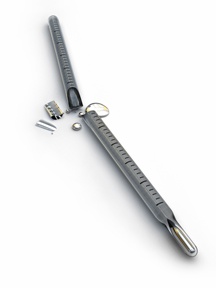 Mercury is a common element found in the lab, particularly in thermometers, barometers, manometers and sphygmomanometers. Given the danger of mercury, many of these instruments are being phased out in place of more environmental- and health-friendly options. As far back as 1991, the Environmental Protection Agency regulated mercury out of latex paint, and in other industries such as pharmaceutical and agricultural, it is being used less and less.
Mercury is a common element found in the lab, particularly in thermometers, barometers, manometers and sphygmomanometers. Given the danger of mercury, many of these instruments are being phased out in place of more environmental- and health-friendly options. As far back as 1991, the Environmental Protection Agency regulated mercury out of latex paint, and in other industries such as pharmaceutical and agricultural, it is being used less and less.
There are three forms of mercury inorganic, organic and elemental mercury, which is most common in the lab. Each is toxic, but organic mercury, which forms in nature, contaminates fish and pollutes waters. Elemental mercury is a silvery and odorless liquid at room temperature, and is the most common source of occupational exposure. The vapors from a spill can “affects the central nervous system (CNS), producing tremors, mood changes and reduced cognitive, sensory, and motor nerve functions. The kidneys are also affected, with renal failure at extremely high doses.”[i]
A recent Lab Manager sited five ways to avoid problems when handling mercury.
- If any mercury compound is used in your workplace, an exposure assessment and hazard evaluation is required for those employees handling the material.
- OSHA permissible exposure limit is 0.01 mg/M3 as an 8-hour time-weighted average for organic (alkyl) mercury compounds with a ceiling of 0.1 mg/M3 for all other mercury-containing materials.
- If you are working with the methylmercury compounds, then you must have those employees thoroughly review and understand the safety data sheets. Develop and follow detailed safety protocols and standard operating procedures (SOPs).
- Perform all work in a fume hood and ensure that employees are using the right personal protective equipment.
- Have a qualified industrial hygienist review the SOPs and conduct the exposure assessments.
Regarding mercury cleanups, the article offered six suggestions:
- Secure the area and prevent any unnecessary foot traffic.
- Use a mercury-binding sulfur powder (or commercially prepared mix) to dust the entire area where droplets are visible.
- Use special mercury vacuum to vacuum up the dust and free mercury.
- If the spill was onto carpet or a porous material, those should be removed and disposed of (as hazardous waste) after vacuuming.
- Impervious surfaces should be dusted and vacuumed at least three times.
- Have a qualified industrial hygienist conduct a clearance assessment, which should include air sampling for vapors.
Visit Lab Manager to review the entire article.
Teledyne Leeman Labs mercury instruments are used to test levels of mercury in seafood and water sources.For more information on these mercury instruments, be sure to visit Mercury Analyzers
[i] http://www.labmanager.com/lab-health-and-safety/2015/06/mercury-rising?fw1pk=2#.VXsm--e8koO

